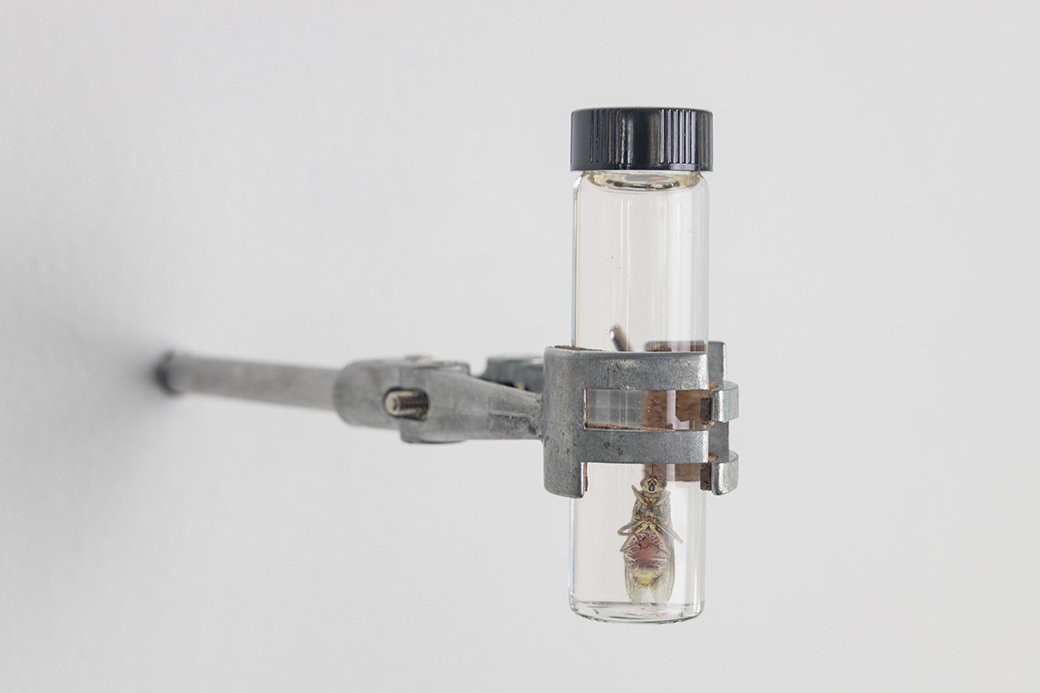



 ngu trap, prototype
1-octen-3-ol, acetone, clay, concrete, cow urine from Indian Zebu, dirt, Indian silk, netting, staples, sticks, twine
dimensions vary
2019
ngu trap, prototype
1-octen-3-ol, acetone, clay, concrete, cow urine from Indian Zebu, dirt, Indian silk, netting, staples, sticks, twine
dimensions vary
2019
When Zebu cattle were introduced to Northeast Africa by European colonizers in the late 19th century, they carried within them the rinderpest virus—a disease commonly known as “cattle plague.” During the spread of rinderpest across East Africa, great swaths of savanna collapsed and were replaced by bushlands. This transformation enabled the expansion of trypanosomiasis (or African sleeping sickness, a disease fatal to livestock and people) via its vector, the biting tsetse fly.
This sculpture is a scale replica of a device used by ecologists, public health officials and herds people throughout East Africa to limit the spread of trypanosomiasis by regulating tsetse fly populations. The trap’s design exploits a combination of visual and chemical cues to attract tsetse, including a liquid bait cocktail of organic chemicals and urine collected from Zebu cows. In India, the ancestral home of Zebu cattle, cow urine is used as a purifying tonic in accordance with ancient Ayurvedic medical texts.
 entanglement catalysts, rendering detail
acetone, cow urine from Indian Zebu, metallic utility clamp, tsetse fly, vial
4” x 12”
2020
entanglement catalysts, rendering detail
acetone, cow urine from Indian Zebu, metallic utility clamp, tsetse fly, vial
4” x 12”
2020
In Entanglement Catalysts, the body of a tsetse fly is preserved in a 1:4 mixture of gomutra (Zebu cow urine) and acetone. When the gomutra in this formula is replaced with water, the mixture becomes a lab-grade preservation solution for arthropods.
 latin square
archival ink-jet print, digital collage
24” x 24”
2020
latin square
archival ink-jet print, digital collage
24” x 24”
2020
In mathematics, “latin squares” are NxN matrices in which each row and column contains values 1 to N. Latin squares are used by scientists to randomize sampling procedures, and were applied in the study that optimized the tsetse fly trap liquid bait cocktail. This work uses a 10x10 latin square to randomly distribute fragments of satellite images from the United States Geological Survey’s Earth Explorer that depict locations central to the socio-political and ecological history of East Africa following European introduction of the rinderpest virus. These locations include:
i.) Massawa, Eritrea, where Italian colonists introduced the rinderpest virus to Africa in 1887;
ii.) Langlaagte area of Johannesburg South Africa, where in 1886 George Harrison discovered the gold vein that would fuel the subsumption of rinderpest refugees into colonial, racial-capitalist society;
iii.) Johannesburg’s Settler’s Park, home to the George Harrison memorial statue;
iv.) Nguruman escarpment in Kenya, where the first tsetse fly traps were developed to fight sleeping sickness;
v.) New Haven, CT, home to North America's only tsetse laboratory at the Yale School of Public Health.
 prospector (George Harrison) source photo of George Harrison monument in Johannesburg’s Settler’s Park, taken by Darly Nakuna
collected 2020
prospector (George Harrison) source photo of George Harrison monument in Johannesburg’s Settler’s Park, taken by Darly Nakuna
collected 2020
This series contains three wall works using images of the George Harrison monument taken by South African native Darly Nkuna. Each image is transferred to film, developed, fixed, and unwashed. Photographs are then mounted to the inside of a one-inch deep, clear, waterproof acrylic display case, which is filled with pure gomutra. Over the duration of the exhibition, the remaining traces of fixer chemicals will slowly deteriorate each image. The compounds present in the gomutra bath complicate and catalyze this process.